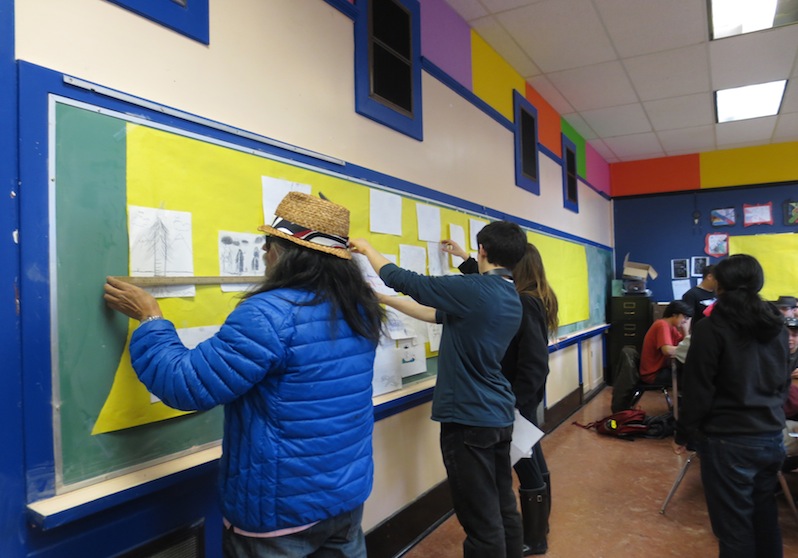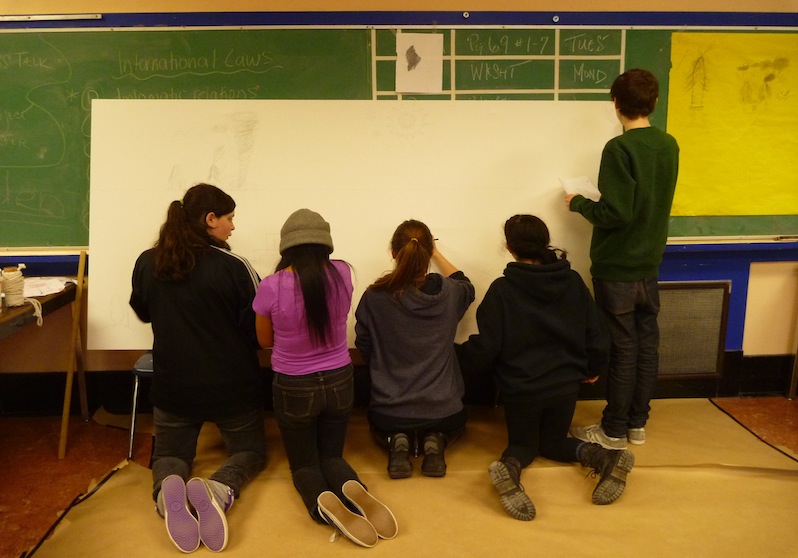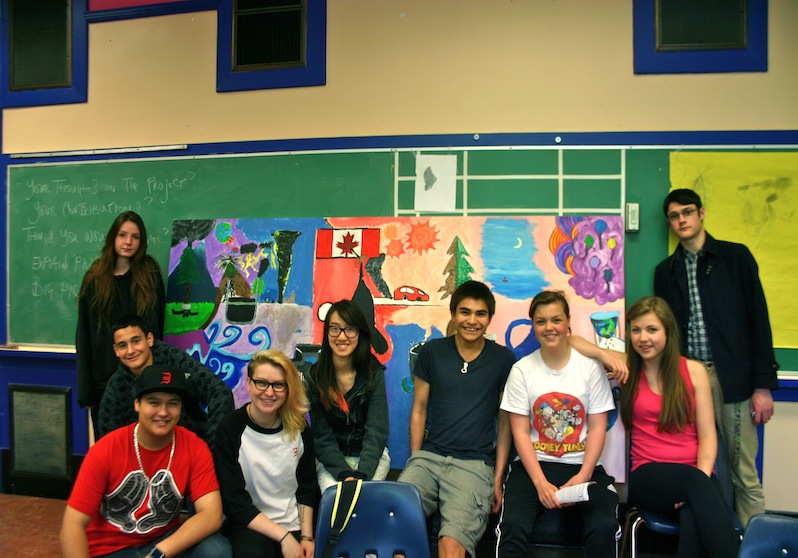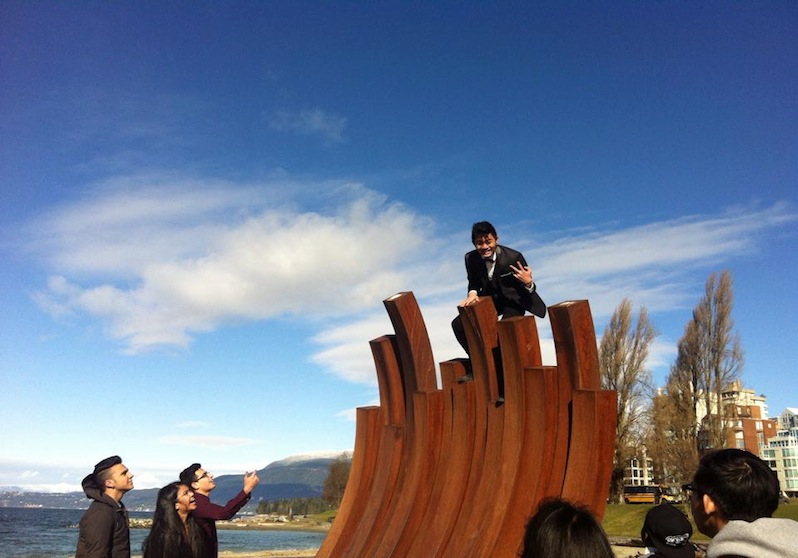Kitsilano Secondary
Arts Education, Social Studies
School:
Kitsilano Secondary Mini School, Vancouver, BC
Teachers:
Manon Desjarlais, Community Schools Team Teacher
Jesse Caswell, Trevor Mills and Jane Wyllychuk
Artist:
Lawrence Paul Yuxweluptun
Class:
Grade 10, 11 and 12 Mini School
Connection with Vancouver Biennale Exhibition:
Vancouver Biennale 2014 – 2014 Artist, Lawrence Paul Yuxweluptun and his artworks:
Red Man Watching White Man Trying to Fix Hole in the Sky; Fucking Creeps They’re Environmental Terrorists; Killer Whale Has a Vision and Comes to Talk to Me about Proximological Encroachments of Civilizations in the Oceans; Indian World My Home and Native Land; Caution! You are Entering a Free State of Mind Zone
Other Sources of Inspiration:
Banksy, graffiti artist
BIG IDEAS:
Creative artistic expression facilitates the development of a collective voice and unifies the hearts and minds of people.
Guiding Questions:
How does intercultural contact and conflict lead to multiple perspectives? What can we do to insure that our voices are heard? What are our true values and what really matters to us? How should these values drive our social, political, and cultural decisions? How can we use art to share our values with others?
Overview:
Lawrence Paul Yuxweluptun, of Coast Salish descent, combines his own experiences with a political perspective. His paintings merge First Nation iconography with a surrealist influence to address West Coast First Nation issues. Yuxweluptun shared with the students how art is a powerful medium to voice political concerns, expose environmental destruction and the struggle of First Nations. Inspired by Yuxweluptun’s artworks and life story, the students explored First Nation history, freedom of expression and the way that art can play an active role in changing perceptions of the world around us. Students began an inquiry into social and environmental issues that they care about, and the strategies that artists can use to convey their opinions and enact change. Choosing to address the recent controversial pipeline projects in BC, the students created a portable mural to share their voice with the whole school.
Cross-Curricular Access:
Arts Education: Artistic strategies for conveying a message, design creation and mural arrangement, learning about art as a political medium, drawing and painting skills
Social Studies: Learning about First Nations history, the history of land claims in Canada, the impacts of colonization including residential schools and important Canadian government policy, environmental issues relating to the pipeline projects in BC, government procedures when deciding on large scale industry projects
Learning Process:
The project began with an introduction by Indigenous artist Lawrence Paul Yuxweluptun, as he discussed his motivations for becoming an artist and the ways that art can be used to address inequality and power structures. Students discussed moments from past and present First Nation history such as The White Paper of 1969, residential schools, land claims and the stewardship of the environment and how different forms of art can address and raise awareness about these issues. Students were empowered to use art as an extension of their freedom of expression, linking a growing culture of social action in the First Nation’s community with their own vision of a mural that would convey a powerful message to their school. After choosing what they wanted to present to their school, students explored different artistic strategies to provoke change such as satire, graffiti and the use of First Nation imagery. In consultation with the artist, students worked in groups to create the designs that would best express their message on a mural.
Student Creation:
After learning about First Nation history and discussing different social issues, students chose to share their opinions with the school on a mural about the upcoming pipelines projects in BC, their connection to First Nations land claims and the environmental impact they will create. The students then designed the mural in groups and discussed how best to arrange the mural to convey a collective message.
Taking Action:
After learning about a variety of social and environmental issues students chose to take action by conveying their informed opinions of the pipeline projects through their designs on the mural.
Project Timeline:
February:
• introduction of Vancouver Biennale Project
• workshops with Lawrence Paul Yuxweluptun, including power point of current and past artwork
• discussion of First Nation history and art
• creation of collective message and concept
• working in groups to create designs for mural
March:
• arrangement of designs with help of artist to best convey their message
• draft designs on canvas
• final design on canvas and presentation to the school
Reflection
Teacher: Manon Desjarlais
Globally speaking it has been a great opportunity for the students and staff of our school. We had the privilege of having an international Coast Salish artist at the invitation of Katherine Tong. The art sessions that the artist did with our First Nations students was very valuable in many area of learning including the development of their self-esteem and artistic skills. The students did choose pipeline as a theme for the mural. They have produced drawings and did painting on the theme of destruction of nature by accepting pipeline project in BC environment. The influence and power of politicians related to economy of BC are represented among student’s drawings.
The relationship the artist was having with the students was noticeable with connection for belonging to their culture & having a voice on important issues. The artist gave opportunities to students to express themselves in front of the class explaining the meaning of their drawing related to the theme “ Say No to Pipeline project in BC, let’s protect our environment now and for future generations”. A strong message from the artist to the students was not to stay passive if something is happening in our culture and society. Perhaps using art on any form of support send a message and become a strong universal tool for people to reflect on our societal problems. Hopefully some of the learning experience will stay with students first nations of Min-School now and in their future journey.
I didn’t know what to expect when I did apply for the grant at the beginning of the submission at Biennale 2014. I have to say that I was overwhelm by the quality of the guest artist we had the pleasure to have at Mini-School Kitsilano. Thank you so much for this great experience in the name of students, staff members and administrators.
May I wish all the best success for Biennale 2015 to the team at Biennale organization. I will be please to let other educators know about this special opportunity of having an artist doing art project with students.
Teacher: Jane Wyllychuk
We had the privilege of having Lawrence Paul come four times to speak to our students and guide them in an art project. The impact the artist and his work had on our students was apparent in the discussions we had during and following his visits. The students asked difficult questions about the environment and their role in protecting it. They learnt about the Northern Gateway pipeline project and details surrounding its construction. They explored and discussed what place art has in social commentary. They were forced to look at non-First Nations/First Nations relations from both a contemporary and historical perspective.
I believe that the experience was invaluable for all involved. The students did not always have a “positive” reaction but the challenging subject matter was always discussed. That alone, is a valuable educational experience. I appreciated Lawrence Paul’s candidness and his passion for both art and politics. I would recommend the experience of having an artist come into the classroom to other teachers. The project had me look at my own biases and beliefs about a variety of subjects.
The project was a valuable teaching tool. I am very grateful for the opportunity.
Artist: Lawrence Paul Yuxweluptun
The project was a great opportunity to meet First Nations people in what is normally a fairly segregated nation. It was an important encounter for the students to have.
I feel the project was successful and that the students had fun. It was great to have these kinds of discussions in a non-art class to show that art is valuable and that you don’t have to be an artist to create. It gives them the opportunity to express themselves, to learn skills in order to say something. It is easy to become jaded, and many people don’t know how to go about using their voice. What are you going to do if there is an oil spill and you need to put something on your plaque, your poster? If you don’t know how to express your message in an artistic way, it isn’t going to be seen. This was a valuable project as it gave them a learning experience on how to express their voice through art and why it is important to stand up for their rights.
Students:
“That talking about politics/problems is way easier to show through art. It’s more relaxing through art.”
“A whole new way to look at the world, that I will never forget”
“The creative process that I have learnt was working together with my peers. Also, coming up with a project with people with different ideas.”
“Explore different art styles and work together as a group instead of as individuals”
“I loved it because it was fun to do, fun to learn about him and his art.”
“The positive part was getting to speak about what I really care about through my art.”
“I learned that it doesn’t matter how good you are, its still art even if its good or bad”
“I learned that everyone draws in their own style”
“I found out that I’m not that bad at drawing, the challenge was getting me to draw”
“I learnt… disaster can be drawn into a masterpiece”
“It was positive that everyone’s idea was expressed properly, it was challenging to see everyone’s artistic view”
“I learnt a lot about what happened to native children that I never learnt through a text book”
“I loved how [Lawrence Paul] talked about the environment and the %1”
“I like the theme of the pipeline because I go to the protests and am against it”
“I learnt that everyone has different opinions on the same topic”
“I learnt to think about what matters to you and not to rush your work”
“I like how [artists are] trying to help the world. It is sad how little some people care about these issues”
“I take from this experience that there are many many different ways to look at art”









